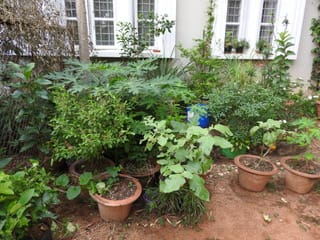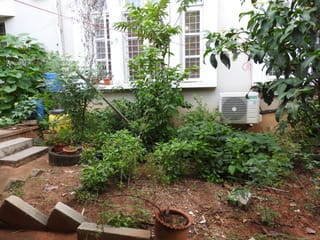I Grew an Urban Forest at Home. Now It Gives Me 17 Kg of Veggies in a Day
“You would not believe how barren and dry my garden once was. And now, I don’t recall the last time I needed to buy leafy greens from the market,” says the urban gardener.

Laxmi Nadendla, a 60-year-old retired nutritionist from Jubilee Hills, Hyderabad began gardening in 2014 when she was introduced to the concept of permaculture. “My house has an expansive area for gatherings, and that year, permaculture expert Padmavathi Koppula from Aranya Agricultural Alternatives, conducted an urban forestry workshop at my home. I was deeply intrigued by their concepts. Taking a look at my dry and dull garden back then, I decided to try my hands at urban forestry and transform the space.”
Her efforts paid off in leaps and bounds. Within a year, her garden of around 2520 sq. ft. was resplendent with plants, all grown organically. She did not harvest any yield for the first few seasons, allowing the plants to redistribute seeds and flourish on their own.
Today, a thicket of plants cover every nook and corner of her garden. “It’s quite the adventure to explore the garden and gather the daily produce for my kitchen,” she laughs.
The seasonal harvest of fruits and vegetables of Laxmi’s garden often exceeds 17 kgs per day.

In an exclusive conversation with The Better India (TBI), Laxmi shares details about her gardening methods while offering a virtual tour of the garden.
From a dry garden with sterile soil to an urban forest
“You would not believe how barren and dry my garden once was,” laughs Laxmi.
Her one-of-a-kind garden is entirely organic and low-maintenance, thriving mostly on its own. She grows a wide array of vegetables, fruits, flowers and medicinal plants. Every day, her garden swarms with bees and butterflies, which help pollinate her plants without any manual intervention.
“I don’t recall the last time I needed to buy leafy greens from the market,” says Laxmi, sharing how the greens like spinach, amaranth, sorrel, mint, moringa, chives or spring onion pop up anywhere and everywhere in her garden. All she has to do is water them every alternate day or so and forage through the garden while collecting greens for her table.
The yield from her garden is enough to feed the family of four; however, she still needs to procure grains, spices and some other essentials from the market. Any surplus from her garden is donated to the local temple or left as it is, for birds and other creatures.
“My garden is not a manicured one with perfectly trimmed hedges, carefully curated floral bed or ornamental plants,” declares Laxmi. She indicates how her forest garden is all about celebrating nature’s bounty at its best.

Padmavathi tells TBI, “I have known Laxmi for a long time now, since our workshop at her house. She had immediately expressed interest in permaculture. And now, she has created one of the most spectacular permaculture forests in the heart of the city. She regularly shares her produce with her neighbours and has inspired many to learn about the concept. Laxmi ensures that there is zero wastage of any resources – be it rainwater or kitchen waste or dry leaves.”
Padmavathi adds, “Being a nutritionist, she has also taught me how to prepare different kinds of fermented drinks and dishes which are exceptionally healthy and delicious!”
Celebrating Nature
The entrance to her garden is lined with tall trees, including a little bamboo grove. Tall bamboo trees shed leaves abundantly, which in turn helps to supply never-ending mulch and compost for the garden. The bamboo patch also helps generate ample shade for the smaller shrubs growing around it.
Among vegetables, Laxmi grows almost every common vegetable found in India ranging from potatoes, several types of tomatoes, turmeric, chillies, gourds, garlic, tapioca, string beans, sweet potatoes, lettuce etc. Her garden also boasts of a large number of fruit trees — pomegranate, custard apple, mango, papaya, lime and even banana, that thrives on recycled greywater from the kitchen outlet. A small patch of medicinal plants also lines the front yard.

The urban gardener resorts to the traditional ways of composting for her garden as well as making mulch. She collects the fallen leaves, dried fibres and kitchen scraps to prepare compost at home in two compost pits. She also makes vermicompost in a large barrel.
“I also follow another innovative Korean method of adding nutrients to my plants. When rice or pulses are kept soaked in water for long, the turbid water that is left is packed with starch and other beneficial nutrients. I add that water periodically to my garden plants,” she reveals.
Once every two weeks or more, Laxmi adds compost and mulch to her plants which helps enrich the soil, retain the natural moisture and prevent soil leaching or erosion. The plants are watered every alternate day through drip irrigation, redirected from a household rainwater harvesting unit. The garden requires barely 25 litres of water. She prefers not to use a lot of pesticides, but whatever she uses is all organic and homemade.

Laxmi believes urban forestry is the most rewarding gardening method. “The yield might not be much in the initial years, but once the soil is naturally replenished over the years, you will be overwhelmed with the bounty. You need to put in minimal effort. The key is to let nature thrive on its own.”
“Urban forestry is the need of the hour. Not only is it highly rewarding for the plants, but it also involves the least amount of maintenance. I would urge every urban dweller to integrate this gardening practice in whatever little plot of land they have at their home,” Laxmi Nadendla tells our readers.
(Edited by Saiqua Sultan)
If you found our stories insightful, informative, or even just enjoyable, we invite you to consider making a voluntary payment to support the work we do at The Better India. Your contribution helps us continue producing quality content that educates, inspires, and drives positive change.
Choose one of the payment options below for your contribution-
By paying for the stories you value, you directly contribute to sustaining our efforts focused on making a difference in the world. Together, let's ensure that impactful stories continue to be told and shared, enriching lives and communities alike.
Thank you for your support. Here are some frequently asked questions you might find helpful to know why you are contributing?


This story made me
-
97
-
121
-
89
-
167














